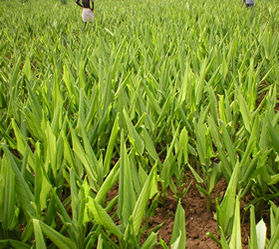|

| Botanical Name |
Curcuma
longa |

|
| Common Name |
English:
Turmeric |
| Family |
Zingiberaceae |
| Parts Used |
Rhizomes |
| Medicinal Property |
A pungent bitter
astringent herb with characteristic small and deep yellow colour. It
stimulates the digestive circulatory and respiratory systems. It has
anti-inflammatory and antibiotic effects. Used internally for digestive
and skin complaints, poor circulation, uterine tumors, jaundice, liver
disease and menstrual problems. Externally for injuries, sores and ring
worm.
|
| Chemistry |
It
contains protein, fat, carbohydrates, fiber, minerals, vitamin A, B, C and
niacin. Volatile oil is orange yellow in colour. About 58 % of the oil is
composed of turmerones and 9 % tertiary alcohols. |
| Description |
A perennial herb,
60-90 cm height, with a short stem and tufts of erect leaves, rhizome
cylindric, ovoid, orange coloured and branched; leaves are simple, very
large; petiole as long as the blade, flowers are pale yellow.
|
| Distribution |
Native of India
and China. Throughout India, and cultivated.
|
| Economics |
Essential
ingredient of curries and curry powder. It is a natural food colouring
agent and also used in colouring silk and wool. |
| Warning |
|
|
|